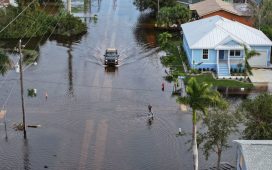This article is an on-site version of our Unhedged newsletter. Sign up here to get the newsletter sent straight to your inbox every weekday
Good morning. Ethan here; Rob’s away this week. In his stead, we’ve got a star-filled line-up of FT subs, including the triumphant return of Katie Martin. Today, some objections to Wall Street’s new favourite bit of jargon. Email me: ethan.wu@ft.com.
No landing and market narratives
If you read the financial press, chances are you’ve heard of “no landing” — the idea the economy might coast along its current resilient growth, sticky inflation path. It is the purported “third scenario” for the economy, alongside landings hard and soft. The writer Kyla Scanlon sums up the thinking in this table:
The no landing story, after floating around for several weeks, has gained traction lately, thanks to a bevy of growthflationary economic data. Just in the last week:
-
Core consumer inflation picked up in January for the second consecutive month, driven by a re-acceleration in goods prices.
-
For the first month since June 2022, the producer price index flipped positive in January. As Matt Klein points out, this follows several months of supply chain conditions no longer getting better.
-
Retail sales shot up 3 per cent in January.
-
Defying glum survey data, manufacturing output also rose 1 per cent in January, after a little-noticed jump in new orders in December.
As a result, the Atlanta Fed’s GDPNow estimate of first-quarter real growth, at 2.5 per cent, looks sturdy:
So the economy is still thrumming — which, while probably delaying recession, could sustain inflation and force the Fed to yank up rates even higher.
That outlook is well within consensus. But our gripe with a no-landing scenario is that the concept embeds a category error. The soft vs hard landing debate is about an economic outcome: does bringing down inflation ultimately bring about recession? On the other hand, no landing about the timing of that outcome: how much economic strength does the Fed need to cut through in its inflation fight? A high inflation, perky growth equilibrium isn’t on the table, because, as Deutsche Bank puts it, “No landing is not an option for the Fed”.
No landing, then, can only ever be the prelude to a hard landing or a soft one, which is why thinking of it as a third scenario is misleading. Liberty Mutual’s Tomas Hirst, who we spoke with last week, has a better framing: “recession delayed” (or perhaps more agnostically, “landing delayed”).
Beyond the semantics, another reason to treat no landing cautiously is that recent data may overstate the economy’s resilience. One big reason is weather. As anyone living in New York can attest, the winter has been nearly snowless, a pattern showing up elsewhere in the Northeast. Paul Ashworth of Capital Economics argues this has swayed the data:
The more we see of January’s data, the more it’s obvious that the weather played a key role. Much of the Northeast enjoyed record or near-record high average temperatures and New York City remained snowless for the first time since 1973. Food service sales jumped by 7.2 per cent m/m last month, leaving them 48 per cent above the average level in 2019. Admittedly, that is partly price-related, with grocery food sales up 26 per cent on 2019 levels. Nevertheless, there is scope for food service sales to drop back significantly in the coming months although, since the mild weather has continued into February, that reversal may not occur until March or April.
Ian Shepherdson of Pantheon Macroeconomics also sees weather effects behind much of the vigorous macro data in January, citing a tight correlation between below-trend snowfall and upside payrolls surprises. Earlier this month, after a bumper jobs report startled markets, he wrote:
the surge in payrolls was accompanied by an even bigger spike in aggregate hours worked, which jumped by 1.2 per cent. Again, this likely is a weather effect; people in outdoor occupations can work longer when the weather is better.
The immediate implication of the spike in hours worked and payrolls is that investors now need to brace for strong retail sales, industrial production, home sales, and construction data for January, regardless of the underlying trends.
With the notable exception of housing starts, Shepherdson’s prediction looks prescient. At the very least, we’ll need February data to confirm January’s strong-economy trends.
It’s not just the sellside economists arguing this. In a tweet over the weekend, Third Point’s Dan Loeb flagged good weather and bad seasonal adjustments (as we discussed last week):
[I’m going to] push back on the contention that the “economy is accelerating hard”. This job is sometimes like a game of 3 card monte where the dealer tries to trick you into thinking you see the card. The [consumer price index] and jobs number seems to have exaggerated economic strength due to car sales from balmy weather and some distortion in the January adjustments. We’re seeing some other signs of slowdown — [Evercore ISI economist] Ed Hyman’s manufacturing surveys and some alt data on jobs.
The point is not that we’re certain January was a weather-driven outlier, but that as disinflation has proved bumpy, market narratives have suffered from recency bias. One month ago, after a few good inflation reports, soft landing was the reigning story. Now, after one uglier report and a handful of growth surprises, it’s no landing pushing up rates expectations. How long will the no-landing narrative last if February or March data looks soggy? Watching the latest data is important, but the big picture matters too.
Errata
We made a few regrettable errors in Friday’s letter on credit investments. We said A-rated bonds were the lowest rung of investment-grade debt. It is of course triple-B-minus or Baa3. And our chart of corporate bond spreads over Treasuries mistakenly showed triple-B and single-B yields instead of spreads. Sorry, and thanks to those who wrote in to point out.
One good read
Balloon physics, relevant all of a sudden.












